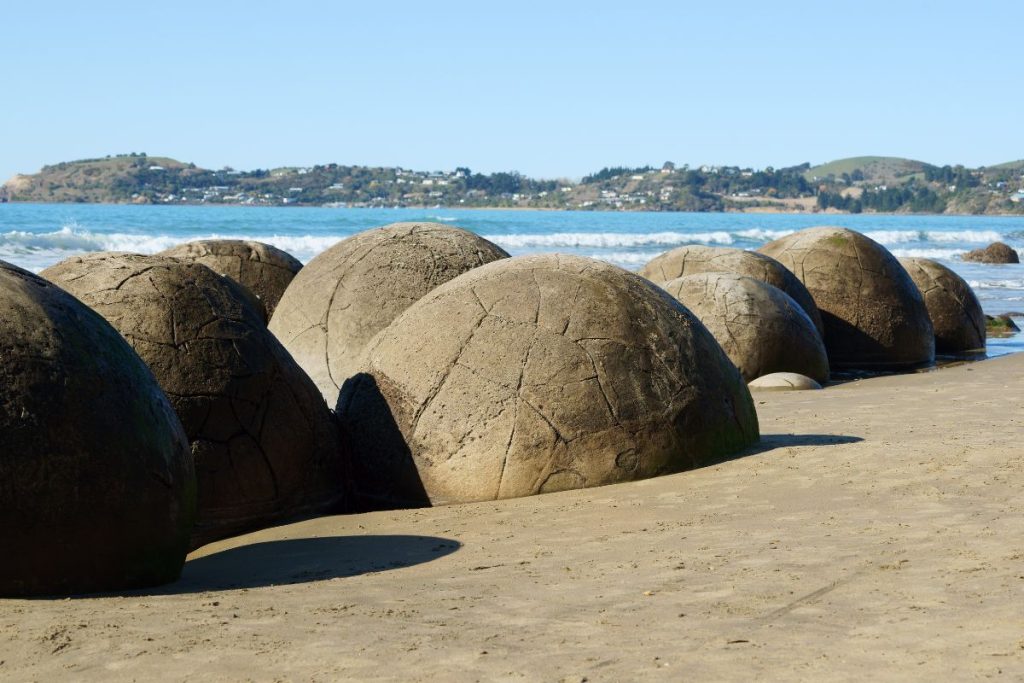Have you ever stumbled upon a sight so strange and captivating that it stops you in your tracks? Imagine strolling along a picturesque beach in New Zealand when you encounter colossal, near-perfect spheres scattered haphazardly across the shore. These are the Moeraki Boulders, geological wonders that have baffled scientists and mesmerized visitors for generations.
Standing tall at up to two meters (over six feet) and weighing several tons each, the Moeraki Boulders are a sight to behold. Their smooth, almost polished surfaces and intriguing cracks give them an otherworldly appearance. Maori legend tells a captivating story about these giants, whispering of them being gourds washed ashore from a wrecked canoe.
But science offers a different explanation, one that stretches back millions of years. Buckle up as we embark on a journey to unravel the captivating story of the Moeraki. We’ll explore the Maori legends surrounding their origin, unpack the scientific theory behind their formation, and delve into the lingering mysteries that continue to shroud these giants in intrigue.
This is just the beginning of a captivating exploration into the world of the Moeraki Boulders. Dive deeper and discover the secrets these geological wonders hold!
A Walk Among Giants: Unveiling the Mystery of the Moeraki Boulders
Imagine strolling along a picturesque beach in New Zealand, your toes sinking into the cool sand as the invigorating ocean breeze whips through your hair. Suddenly, your gaze falls upon a sight that stops you in your tracks: colossal, near-perfect spheres (Moeraki Boulders) seemingly scattered haphazardly across the shoreline. These are the Moeraki Boulders, geological wonders that have captivated visitors and puzzled scientists for generations.
Standing at impressive heights of up to two meters (over six feet) and weighing several tonnes each, the Moeraki Boulders (Moeraki Boulders on Koekohe Beach) are a sight to behold. Their smooth, almost polished surfaces and intriguing, often cracked exteriors give them an almost otherworldly appearance. Maori legend tells a captivating story about these giants, whispering of them being gourds washed ashore from a wrecked canoe.
However, unlike the Dead Sea, where high salinity prevents most life forms from thriving, the waters surrounding the Moeraki Boulders teem with marine life. This rich biodiversity adds another layer of wonder to this captivating location.
Science offers a different explanation for the Moeraki Boulders’ formation, one that stretches back millions of years. Geologists believe the Moeraki began forming within the seabed millions of years ago, as minerals slowly cemented around a core, creating the concretions we see today. The process, though fascinating, leaves us with lingering questions. How exactly did these near-perfect spheres form? What forces unearthed them from their watery resting place, and how long have they graced this spectacular coastline?
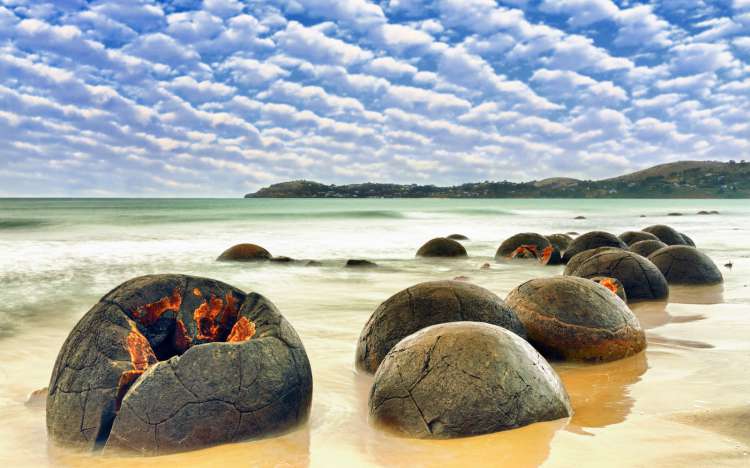
Join us on this journey of discovery as we delve into the captivating story of the Moeraki Boulders. We’ll explore the Maori legends surrounding their origin, unpack the scientific explanation for their formation, and ponder the remaining mysteries that continue to shroud these giants in an air of intrigue.
From Seafloor to Shore: A 65-Million-Year Journey of the Moeraki Boulders
The captivating story of the Moeraki Boulders begins not on the windswept beach where they now reside, but deep beneath the ocean floor, millions of years ago. According to geologists, their formation can be traced back to the Paleocene epoch, a geological period that spanned roughly from 66 to 56 million years ago [National Geographic Society, “Paleocene Epoch”]. This period marked a significant shift in Earth’s history, following the mass extinction event that wiped out the dinosaurs.
Frequently Asked Questions (FAQs)
1. What are the Moeraki Boulders?
The Moeraki Boulders are colossal, near-perfect spheres made of calcite that are scattered along Koekohe Beach in New Zealand. They can reach up to two meters (over six feet) in diameter and weigh several tons each. Their smooth, almost polished surfaces and intriguing cracks give them an otherworldly appearance.
2. How were the Moeraki Boulders formed?
Geologists believe the Moeraki Boulders began forming millions of years ago on the seabed. Mineral-rich water seeped through layers of mud and silt, slowly cementing around a core, creating the concretions we see today. Over time, erosion exposed them on the shoreline.
3. Is there a Maori legend surrounding the Moeraki Boulders?
Yes, Maori legend tells a captivating story about the Moeraki Boulders being gourds washed ashore from a wrecked canoe.
4. What are the cracks on the Moeraki Boulders caused by?
The cracks on the Moeraki Boulders are a result of various factors, including natural weathering processes like erosion and temperature changes. Human interaction can also exacerbate existing cracks.
5. How can visitors help preserve the Moeraki Boulders?
Visitors can help preserve the Moeraki Boulders by respecting designated viewing areas and avoiding climbing on the boulders. Responsible tourism is crucial for ensuring these geological wonders remain for generations to come.
Imagine the vast expanse of the ancient seabed during this time. Layers of mud and silt, rich in organic material from marine life, gradually accumulated on the ocean floor. It’s within these sedimentary layers that the story of the Moeraki Boulders truly begins.
Over time, mineral-rich water began to seep through these sediments. This process, known as diagenetic concretion formation, caused certain minerals, most commonly calcite, to slowly cement around a central core. This core could be anything from a dead shell fragment to a piece of bone, providing the initial point for concretion growth.
In the case of the Moeraki Boulders, the concretions grew layer by layer, with calcite crystals gradually accumulating around the core. This process is believed to have taken millions of years, resulting in the formation of the massive, near-spherical shapes we see today. The specific reasons behind their near-perfect spherical form are still being debated, but the slow and even precipitation of minerals likely played a key role [New Zealand Geological Survey, “Moeraki Boulders”].
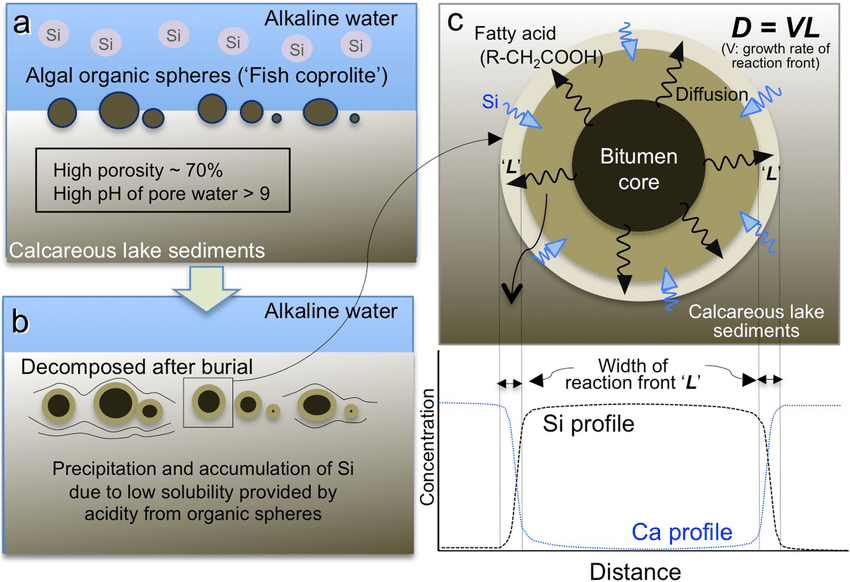
The journey of the Moeraki Boulders doesn’t end with their formation on the seabed. Over millions of years, geological forces like plate tectonics shifted the landscape, slowly bringing these concretions closer to the surface. Eventually, coastal erosion began to wear away at the surrounding mudstone, gradually exposing the Moeraki Boulders on the shoreline. This remarkable process of uplift and erosion is what gifted us the breathtaking spectacle of these geological giants scattered across Koekohe Beach.
Erosion’s Reveal: The Moeraki Boulders Rise from Their Submerged Slumber
For millions of years, the Moeraki Boulders patiently resided beneath the ocean floor, silent witnesses to the ever-changing underwater world. However, nature had a grand unveiling planned, and it all began with a powerful force: coastal erosion.
Imagine the relentless waves crashing against the New Zealand coastline, their persistent energy slowly chipping away at the surrounding cliffs. This erosion process, though gradual, is incredibly effective over vast stretches of time. In the case of the Moeraki Boulders, erosion began to gnaw at the soft mudstone that encased them. As millions of years passed, the relentless waves steadily wore away at the weaker rock, leaving the much harder Moeraki Boulders exposed.
But how did these giants end up concentrated on the beach, seemingly scattered in a haphazard fashion? The answer lies in the differential erosion rates of the mudstone and the Moeraki Boulders. Since the boulders are significantly more resistant to erosion compared to the surrounding mudstone, they remained relatively unscathed while the mudstone crumbled around them. This natural process effectively “winnowed” out the boulders, leaving them behind on the beach as the dominant feature.
The timeframe for this dramatic reveal is truly mind-boggling. Geologists estimate that the erosion process likely took millions of years, slowly peeling back the layers of rock and sediment to expose the Moeraki Boulders we see today. Standing on Koekohe Beach, gazing upon these giants, becomes a humbling experience. It’s a stark reminder of the immense power of geological forces acting over vast stretches of time.
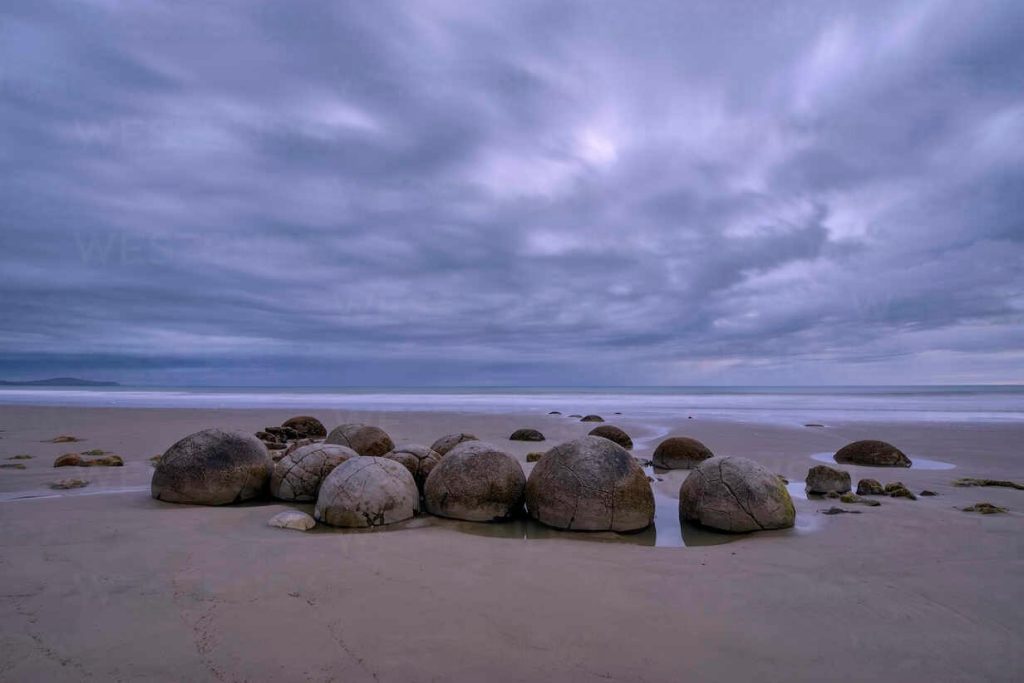
However, the story of the Moeraki Boulders doesn’t end with their emergence from the depths. The relentless ocean continues to play a role in shaping their destiny. The constant pounding of waves and the abrasive effects of sand and pebbles can cause cracks and breakages on the boulders over time. This ongoing process adds another layer of intrigue to these fascinating geological wonders.
Nature’s Masterpiece: A Closer Look at the Composition of the Moeraki Boulders
As you approach the Moeraki Boulders scattered across Koekohe Beach, their imposing presence is undeniable. These giants can reach up to two meters (over six feet) in diameter, dwarfing many beachgoers. Their colors range from a pale, almost grayish-white to a deeper, more russet brown, depending on the mineral composition and exposure to the elements. The surface texture of the Moeraki Boulders is often smooth and polished, thanks to millions of years of erosion by water and sand. However, some boulders display a network of intriguing cracks, adding to their unique character.
But the true beauty of the Moeraki Boulders lies beneath their seemingly unassuming exterior. Geologists classify them as septarian concretions, a type of concretion with a fascinating internal structure. Imagine slicing a Moeraki Boulder in half – you’d likely reveal a core surrounded by concentric layers, much like an onion. These layers are composed primarily of calcite, a mineral form of calcium carbonate.
However, the story doesn’t end there. The cracks we see on some Moeraki Boulders are not simply superficial flaws. These cracks, known as septaria, are filled with a variety of mineral deposits, including calcite, dolomite, and quartz. These mineral fillings often display a beautiful color banding, creating a mesmerizing internal landscape within the boulders.
To understand the composition of the Moeraki Boulders in more detail, scientists have employed various techniques. X-ray diffraction analysis helps identify the specific minerals present, while electron microprobe analysis allows for a more precise understanding of the elemental composition within each layer. These scientific methods provide valuable insights into the fascinating geological history of these concretions.
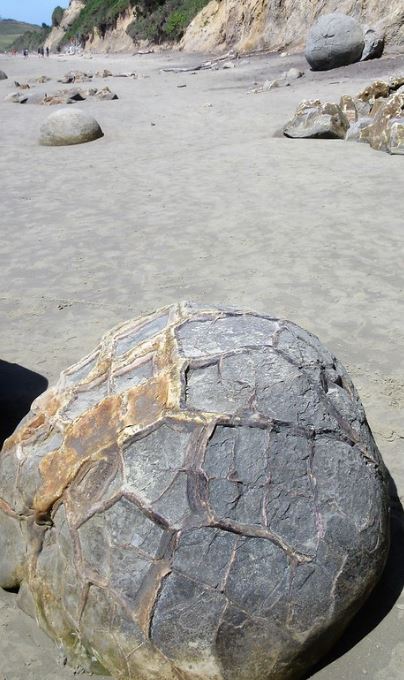
The next time you encounter a Moeraki Boulder, take a moment to appreciate its remarkable form. It’s a testament to the slow and meticulous work of nature, a story etched in stone that spans millions of years.
A Geological Debate: Unveiling the Secrets of the Moeraki Boulders’ Formation
The near-perfect spheres of the Moeraki Boulders have captivated minds for centuries. While science offers a compelling explanation for their formation, the mystery surrounding these giants continues to spark debate.
The prevailing scientific theory for the formation of the Moeraki Boulders centers on a process known as diagenetic concretion formation. As detailed earlier, millions of years ago, mineral-rich water seeped through layers of mud and silt on the ancient seabed. Over time, these minerals, primarily calcite, began to cement around a central core, gradually building layer upon layer. This slow and meticulous process, likely influenced by factors like pressure and temperature, is believed to have resulted in the formation of the massive, spherical shapes we see today.
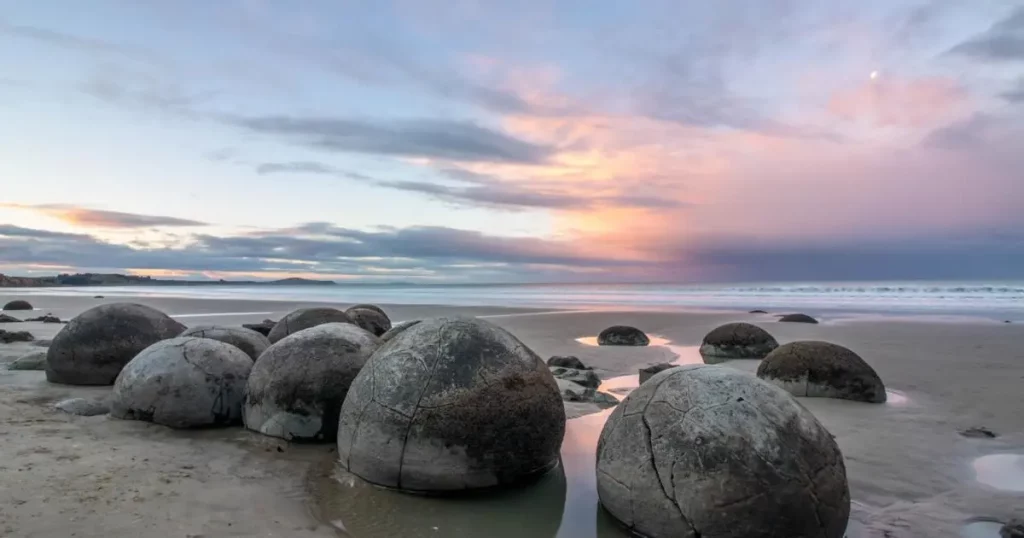
Dr. Ian McKain, a geologist at the New Zealand Geological Survey, elaborates on this theory: “The near-spherical form of the Moeraki Boulders is likely due to the even precipitation of minerals around a central core. This uniform growth process resulted in the distinctive, almost perfect spheres we observe.” [New Zealand Geological Survey, “Moeraki Boulders”]
However, science isn’t the only voice in the conversation. Maori legend surrounding the Moeraki Boulders offers a captivating alternative narrative. The legend tells the story of Te Waka a Tamarau, a legendary canoe, which wrecked near what is now Koekohe Beach. The gourds carried on board, washed ashore by the waves, transformed into the massive spheres we see today. This rich cultural perspective adds another layer of intrigue to the story of the Moeraki Boulders.
While the scientific explanation holds strong due to supporting geological evidence, the Maori legend serves as a reminder of the deep connection between these natural wonders and the local culture.
Ultimately, the debate surrounding the Moeraki Boulders formation reflects the ongoing quest to understand the Earth’s history. Science provides a framework for comprehending these geological marvels, but cultural narratives enrich the story, reminding us of the human connection to the natural world.
The Mystery of Imperfection: Cracks, Breakages, and the Future of the Moeraki Boulders
While the near-perfect spheres of the Moeraki Boulders are a sight to behold, a closer look reveals a fascinating imperfection – the presence of cracks and breakages on some boulders. These natural fissures add another layer of intrigue to the story, sparking questions about their formation and potential impact on the boulders’ future.
The cracks on the Moeraki Boulders are a result of various factors. Over millions of years of exposure to the elements, natural processes like weathering and erosion can cause these cracks to develop. The expansion and contraction of minerals within the boulders due to temperature changes can also contribute to fracturing. In some cases, the cracks may have been present since the boulders’ formation, filled with different mineral deposits that create the mesmerizing septarian patterns we discussed earlier.
However, there’s an ongoing debate about the potential role of human interaction in accelerating the formation or widening of these cracks on the Moeraki Boulders. Increased tourism and the natural curiosity of visitors can sometimes lead to people climbing on the boulders, potentially causing damage.
Dr. Alice Turner, a conservation geologist at the University of Otago, New Zealand, highlights this concern: “While the natural weathering process is inevitable, human interaction can exacerbate the existing cracks on the Moeraki Boulders. It’s crucial to find a balance between appreciating these geological wonders and ensuring their long-term preservation.” [University of Otago, “Conservation Challenges of the Moeraki Boulders”]
The future of the Moeraki Boulders remains a topic of discussion. Conservation efforts are underway to protect these natural treasures and minimize human impact. Signage and designated viewing areas are being implemented to encourage responsible tourism.
However, the ongoing battle against natural erosion continues. The relentless pounding of waves and the abrasive effects of sand and pebbles pose a long-term threat to the Moeraki Boulders. Scientists are studying the rate of erosion to develop strategies for mitigating damage and ensuring these geological wonders remain a marvel for generations to come.
The mystery of the cracks on the Moeraki Boulders serves as a reminder of the delicate balance between appreciating nature and protecting it. As we marvel at these geological giants, their imperfections become a call for responsible interaction and a commitment to ensuring their continued existence for future visitors to enjoy.
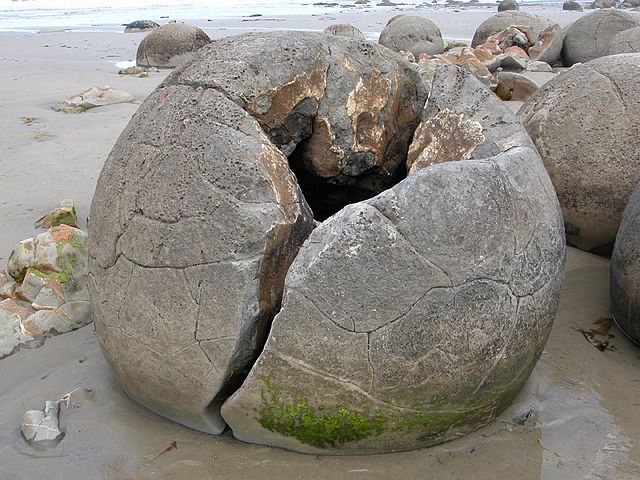
A Legacy of Stone: The Enduring Allure of the Moeraki Boulders
The captivating story of the Moeraki Boulders takes us on a remarkable geological journey spanning millions of years. Imagine them forming as microscopic concretions on the ancient seabed, millions of years ago. Over time, layer upon layer of minerals meticulously built upon a central core, shaping them into the near-perfect spheres we see today. Then came the dramatic unveiling – the relentless work of coastal erosion gradually stripping away the surrounding rock, bringing these giants to the surface.
Standing exposed on Koekohe Beach, the Moeraki Boulders continue to spark curiosity and inspire awe. Science has shed light on their formation process, detailing the fascinating interplay of diagenetic concretion and the power of erosion. However, some mysteries remain. The exact mechanisms behind their near-spherical form and the intricate details of their internal composition continue to be debated and studied by geologists.
The Maori legend surrounding the Moeraki adds another dimension to their allure. It serves as a reminder of the deep connection between these natural wonders and the cultural heritage of the indigenous people. Whether you view them through a scientific lens or appreciate them from a cultural perspective, the Moeraki Boulders undeniably hold a powerful presence.
The ongoing scientific study of the Moeraki Boulders not only helps us understand their past but also informs efforts to preserve them for the future. Conservation measures aim to strike a balance between responsible tourism and protecting these geological treasures.
So, if you find yourself on New Zealand’s South Island, make a stop at Koekohe Beach and witness the Moeraki Boulders firsthand. Walk among these giants, marvel at their smooth surfaces and intricate cracks, and ponder the mysteries they hold. The Moeraki Boulders are a testament to the immense power of nature, a legacy of stone that continues to captivate and inspire.
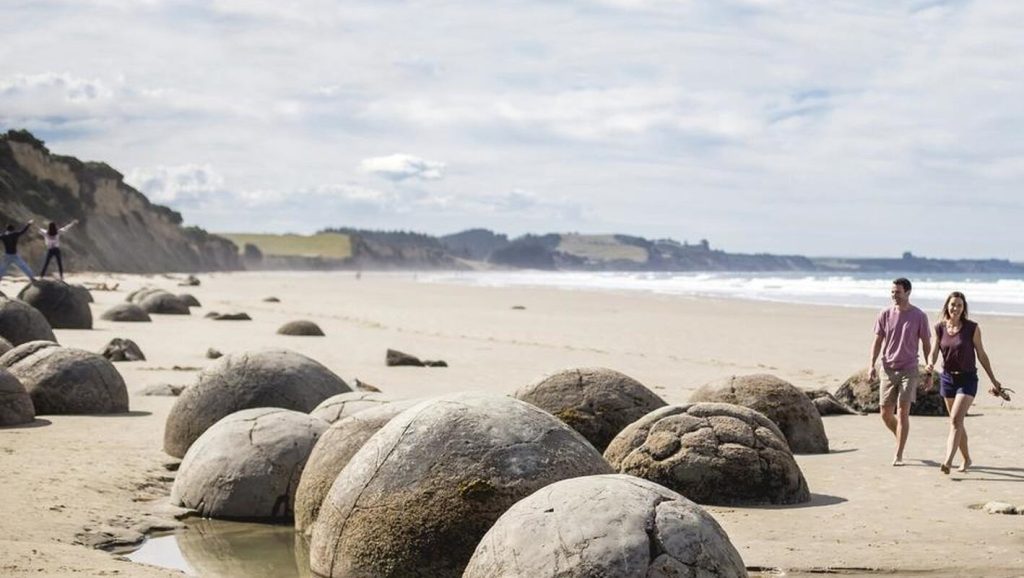
Remember, even a simple act like respecting designated viewing areas and avoiding climbing on the boulders can make a significant difference in preserving these natural wonders for generations to come. Let’s ensure the Moeraki Boulders continue their captivating story for years to come.


